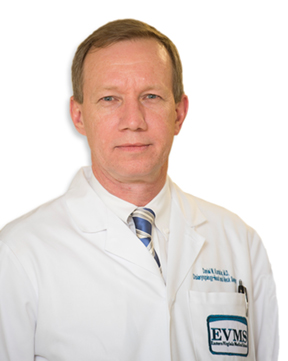 Otolaryngology
Otolaryngology
Head and Neck Oncological Surgery,
Thyroid and Parathyroid Surgery
Eastern Virginia Medical School
In 1993, when Dr. Daniel Karakla completed his residency in otolaryngology at Naval Medical Center Portsmouth, there were two options open to patients with laryngeal cancer: largyngectomy (either partial or total) or radiotherapy. Chemotherapy at that time was generally only for palliation.
“Between World War I and World War II, radiation therapy was used broadly for head and neck cancer patients,” Dr. Karakla says. “And as chemotherapy agents improved, that modality became a stronger part of the treatment.”
Today, the pendulum is swinging more and more back toward surgery, he notes, because different surgical innovations and reconstruction techniques offer patients hope for a more normal quality of life. Many of those innovations, described herein, were brought to EVMS by Dr. Karakla.
Although radiation, chemotherapy and surgery, or a combination, are still widely employed when individual cases merit, “We always want to steer our patients toward organ preservation whenever possible,” Dr. Karakla says . “And whenever possible, we offer a partial laryngectomy rather than a total.” Every head and neck cancer patient is presented at a multidisciplinary conference, to determine the best and most effective course for each individual patient.
Depending on the location of the tumor, some patients with smaller cancers are candidates for a partial laryngectomy, which removes only part of the voice box. These procedures leave some or even all of normal speech unaffected, and swallowing is ideally unimpeded.
In a total laryngectomy, however, the entire voice box is removed, and patients can no longer speak normally. In either case, but especially for total laryngectomy patients, there is a huge life change, Dr. Karakla knows, and thus he emphasizes that “…any time we have to offer a patient a larynx removal, we should be talking about how we can rehabilitate them to be as normal as possible in terms of speaking and swallowing after surgery and recovery.”
Dr. Karakla learned voice restoration in his Head & Neck Surgery/Microvascular Reconstruction fellowship at Methodist Hospital of Indiana from Drs. Blom and Hamaker, and he remains a staunch advocate.
The earliest options for laryngectomy patients included the electrolarynx, a battery-operated device placed under the patient’s mandible, which produced vibrations and enabled speech. “The sound was mechanical and could be very difficult to understand,” Dr. Karakla says. Today, he can assist patients by recommending other voice restoration devices, while emphasizing to these patients that they require intensive work with a speech-language pathologist for the technology to be optimal.
For patients with tongue based and/or tonsil cancers, Dr. Karakla offers transoral robotic surgery. If patients have select cancers in that area, with neck metastasis that is still resectable – within certain limits, he says – “We can do transoral robotic surgery as the primary management, followed by lower dose radiation.”
Dr. Karakla recognizes the current epidemic of HPV related throat cancers: in the last decade, there has been at least a four- to five-fold increase in the number of oropharynx cancers in the US. He believes many of those patients can successfully have surgery prior to other modalities, then followed by low dose radiation. Some might not even require chemotherapy. “We’ve offered that course for the past five years,” he says, “and we’re seeing similar cure rates, and better functional swallowing.”
In addition to caring for his EVMS patients, once a year, Dr. Karakla joins several other Hampton Roads physicians for a medical mission to the Philippines. “It’s the northern part, near Luzon, very rural and remote,” he says, “where we treat the local population – mostly rice farmers – and provide the only specialized medical and surgical care these people receive.”

